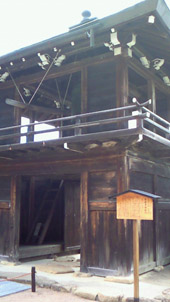Temples & Shrines
Temples
Unryuuji (‘Cloud Dragon’ Temple)
Unryuuji is located at the starting point of Higashiyama Promenade in Teramachi (Temple Area), home to many temples. Unryuuji has strong connections to Takayama Castle. Its gate tower is thought to have been moved from the Kouun Pavilion of Takayama Castle, while the main hall of Hokkeji (Temple) was transferred from the castle. It is also the familytemple of Naganori Kanamori, the eldest son of Nagachika Kanamori, who died in an incident at Honnoji in 1587. There are old trails called ‘Edo Kaido’; the resting place for which lies on this promenade.
Daiouji (temple)
This is a temple of the Jodo sect located in front of Yasukawa Street. Although it used to be a large temple complex, housing 5 sub temples, there is currently only one sub temple called Dounin. However, the temple still boasts an outstanding Buddhist monastery amongst those in Higashiyama. Important cultural treasures such as the Niou Mon (gate), Sho Rou (bell tower), the large main hall, and a hexagonal temple are all lined up on a tall stone wall. Many people visit here as a beauty spot to watch the autumn colors in Higashiyama.
Sogenji (‘Prairie’ temple)

Sogenji (temple) is located on the opposite side to Daiouji (temple) across highway 158. It is a temple of the Soto sect with Buddhist monasteries standing on a tall stone wall. It was built as a family temple of Nagachika Kanamori by Arishige Kanamori, the second generation of the family. The main hall was transferred from Takayama castle and used to be a chamber within the latter.
Tenshouji (‘Heavenly’ temple)

This temple was built during the period 1182~1185 by Shinkuu Meishou Daiajari and used to be home to the Tendai Sect, who subsequently became extinct. The temple was then rebuilt as a temple of the Jodo sect during the period 1615~1624. This is the temple where Mitsumasa Kato, grandson of Kiyomasa Kato, and Tadateru Matsudaira, 6th son of Ieyasu Tokugawa, used to stay. Tadateru Matsudaira was banished to Hida because of his falling out with his father. There is currently a youth hostel adjacent to the temple, which is used by many foreign backpackers
Hokkeji(temple)

Hokkeji, which faces those who come up the Ebi zaka (slope) from Sanmachisuji, is the only temple of the Nichiren sect in Hida. It was built in 1558, with the main hall later donated by Shigeyori Kanamori as a family temple of Mitusumasa Kato, lord of Higo but banished to Hida and belonging to the Nichiren sect. Mitsumasa died young at just 20. The stone Buddha next to the main hall is called ‘Arai Botoke’ and it is believed that if you wash the same part of the Buddha as diseased parts of your body with a scrubbing brush, you will be able to recover from illness.
Zennouji (temple)

Zennouji was a family temple of the lord of Matsukura castle, Mr. Mitsuki, who lost in the battle with Nagachika Kanamori. It was later moved here and had to be rebuilt after being burned down in the battle. The main Buddha Nyoirin Kannon was made in India, with instructions given to bring it to Japan by a Zen reverend Sousai. The temple offers a Zazen experience for everyone wishing to try at the Zazen hall located inside the main hall. Telephone reservations are necessary if you wish to try.
Soyuuji (temple)
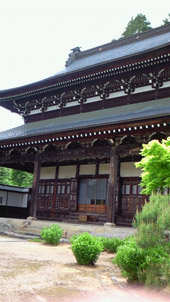
Soyuuji is located in the southernmost area of Higashiyama Teramachi and next to a stone wall made with huge stones transferred from Takayama castle. It is a temple of the Rinzai sect with a multilayered Buddhist monastery. The temple was built in 1632 by brothers, Shigeyori Kanamori and Shigekatsu. During the Meiji Restoration, Tesshuu Yamaoka helped ensure the bloodless capitulation of Edo castle by mediating between Takamori Saigo and Kaishuu Katsu. Tesshu Yamaoka spent his teens in Takayama and is said to have studied and learned Zen in this temple, since his father was a 21st generation Hida county officer.
Hida Kokubunji (temple)
img_area
Among the temple’s treasures are the national cultural treasure of the main hall and the main Buddha of Yakushi Nyorai Onzo Seikanzeon Bosatsu, The prefectural cultural treasure includes Amida Nyorai Fudoumyouo and the three-storied pagoda, which is the only one of its kind in Hida. The large ginkgo tree is a designated national monument. The temple was built in 764 by Emperor Shoumu as one of several provincial temples. It is located on the Kokubunji Street and houses a main hall, the three-storied pagoda and the bell tower gate within large precincts. The three-storied pagoda was rebuilt in 1821 and is currently the only pagoda in Hida. Although originally a seven-storied tower in the Nara era, it gradually diminished and was rebuilt as a five-storied tower, followed by three-storied whenever there was a war and disaster. There is a huge stone 1.8 meters in diameter in the precincts, which is thought to be the former foundation stone of the seven-storied tower. There also a large 38 meter high ginkgo tree in the precinct, which is a designated national natural monument.
* A folk tale A large gingko tree in Kokubunji (temple)
During the Shoumu emperor’s era, excellent leaders were appointed to manage the building of Kokubunji, which was to have a seven-storied tower in Hida. However, when the carpenters started cutting the timbers, the central pillar was not long enough. The leader’s faces turned blue. Yaegiku, the daughter of the leader, asked and found the reason from her suffering father. She said lightly ‘If the timber is not long enough for the center pillar, how about making the frame instead, which could also be decorative? ’ Having been helped by his daughter’s great idea, the leader completed the building of the seven-storied tower with a frame. People who looked at the tower complimented the leader’s skill and the beauty of the frame was a particular talking point. The leader was initially delighted, but as the frame become more famous, he gradually became worried that people may find out that the idea was actually that of his daughter. One night, the leader killed the daughter, buried her body in the grounds of Kokubunji and planted a gingko tree. This is said to be the largest gingko tree in Kokubunji.
Takayama Betsuin (branch) Shourenji (temple)
img_area
This large outstanding temple in Takayama is the Takayama branch temple of the Jodo Shinshuu Otani sect, with a large main gate in the front of a wide road approaching a temple. Jodo Shinshuu has been the mainstream of Buddhism in Hida and this betsuin (branch) has been respected by many people beyond those in the various Buddhist sects. Koukizan Shourenji (temple), which was originally in Shirakawago Nakano, used to wield power sufficient to frighten lord Uchigashima as the main temple for disciples of the Shinshu sect in Hida. Nagachika Kanamori united with disciples of the Shinshu sect when he subjugated Hida. As a prize to the disciples, he arranged to move Shourenji to Takayama and built a large temple with a large precinct. The temple is currently Higashihonganji Betsuin (branch) since Shourenji’s lineage came to an end after the 17th generation.
Nakano Shourenji (temple)
img_area
This is the oldest temple of the Jodo Shinshu sect in Japan, situated in the outer citadel of Shiroyama Park. About 700 years ago, Kanenbou Yoshitoshi, who was told to be a disciple and prince of Emperor Gotoba, started work as a missionary in Shirakawago from Mino. He opened a dojo studio in Hatogaya and made the place a center for the Jodo Shinshu faith. The temple belongs to the same faction Takayama Kyouku Takayama Ichikumi and is commonly known as ‘Nakano Shourenji’.
* Fukurai Hakase memorial hall
In this hall, research articles by Dr. Tomoyoshi Fukurai, who researched spiritual photography, clairvoyance and psychic ability, are exhibited. There are also samples of experiments performed by psychics such as Chizuko Mifune (the model of the novel ‘Ring’), Ikuko Nagao, Sadako Takahashi, and Kouichi Mita.
Shrines
Higashiyama Hakusan Jinja (‘White Mountain’ shrine)
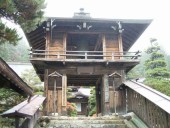
This shrine, which was built in 720, is the oldest in Takayama. It was moved to the current location to avoid the taboo quarters of Takayama Castle and huge Meoto Sugis (a pair of cedars) lie nearby in the precincts.
Higashiyama Shinmeijinja (‘Lord’s shrine’)
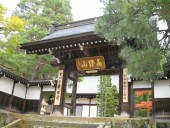
The tsukimi den (moon viewing room) at Takayama Castle was brought to this shrine and rebuilt as an Ema den (votive picture repository). The premises also accommodate a stand and Noh dancing stage for the festival held here, although these are currently dismantled.
Nishikiyamajinja (‘Brocade Mountain’ shrine)
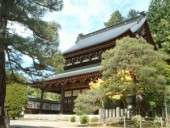
Nishikiyamajinja is located opposite Shiroyama, which is in the south of Higashiyama. It used to house Kongouji, a temple of Shugendou, and is considered one of the top three shrines in Higashiyama. It currently has small Shinto shrine constructions.
Enajinja (shrine)
img_area
Enajinja was built in 1815 by Taishu Tanaka who was a Kokugaku (Japanese classical literature) ideologist in the Edo era and born in Takayama. After investigating the Inaokimori woods next to the Edo Kaido (highway), he found there used to be an old shrine of Arina Myoujin which was in the Engishiki, whereupon he rebuilt the shrine there and his own house next to it. Taishu Tanaka was an apprentice of Norinaga Motoori and the author of ‘Taketori Monogatari’ (The Moon Princess). He is said to have taught Japanese classical literature and Waka (31-syllable Japanese poems) to more than 300 apprentices; both from Hida and outside Hida beside this Enajinja. The Taishu book collection is called the Ena book collection and kept in local history museum (Takayama City kyoudo-kan).
Yamazakurajinja (shrine)
img_area
There is a small alley-like shrine in the Arcade town. On New Year’s Day in 1657, Yorinao Kanamori , who was the 4th generation of the Kanamori family, had escaped from the Great Fire of the Edo era when it approached the residence of the Kanamori family by riding his favorite horse Yamazakura. Yorinao appreciated and loved Yamazakura and built the shrine to worship the horse when she died. Ever since, Yamazakurajinja has been a valued talisman against fire.
Hiejinja (Takayama)
img_area
Hiejinja is otherwise known as Hida Sannoumiya Hiejinja and is an old shrine; surrounded by cedars and located south of Shiroyama Park. The old Takayama city is divided into southern and northern areas by Yasukawa dori (street), Hiejinja, the south village shrine and Sakurayama Yawatajinja, the north village shrine respectively. The famous spring Takayama festival is the ‘Sannou festival’ at Hiejinja, which features 12 luxurious festival cars cruising around the south part of town and is held on the 14th and 15th of April.
Sakurayama Hachimangu
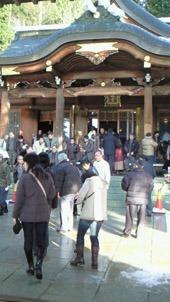
This is an old shrine, which is thought to be the village shrine for the north part of old Takayama city, situated to the north of Yasukawa dori (street). In times of yore, prince Takefurukuma-no-mikoto was sent from the imperial court to subjugate the monster Ryoumen Sukuna, who was controlling Hida. It is said that the shrine originated when this warrior enshrined Emperor Ojin as the deity of this sanctuary and prayed for the success of the mission. The current shrine was rebuilt by Arishige Kanamori in order to protect the north part of Takayama castle. Its festivals are held on the 9th and 10th of October. (Takayama Matsuri). The autumn festival is known as Takayama Matsuri together with the spring festivals at Hiejinja.
Hidasouja(Takayama)
img_area
This old shrine is a prefectural shrine, known as the Souja (* a shrine enshrining several gods) of Hida. It deifies 8 ‘Za’s included in the book of Engishiki Shinto god names. (3 ‘Za’s of Ono-gun, 5 ‘Za’s of Araki-gun) and 10 ‘Za’s that are in the Kokushi respectively. The Sennin (1000 people) procession and Oyako Shihimai by pairs (acrobatic dance by 22 people) are held at the festival on 4th and 5th of May each year.
Hida Tenmangu
img_area
This is situated in the south of Takayama city, on the opposite side of Shiroyama and across the river Miya. This Tenmangu is famous for the god of study. In 901, Michizane Sugawara, who lost in battle with the Fujiwaras, was deported to Kyushu Dazaifu, while his son, Kanemochi Sugawara, was also relegated to mountainous Hida. Kanemochi built this Tenmangu to worship the soul of Michizane Sugawara when he heard of the death of his father. It houses around 100 plum trees, the blossoms of which can be enjoyed from mid-March to mid-April each year.

